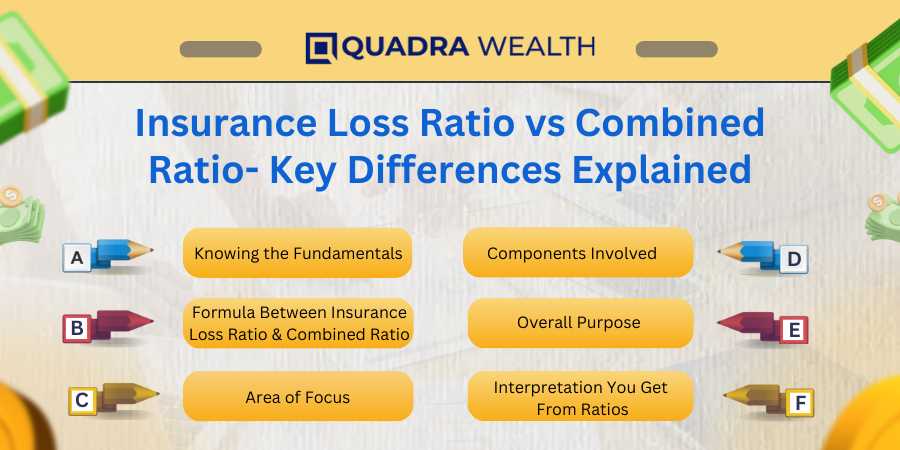Introduction
As an insurance subscriber, you choose your insurance policies vis-a-vis gauging your claim amounts for health insurance, life insurance, or a theft insurance policy. There are quite several interesting factors that help you choose the right type of insurance provider for your insurance needs.
However, for you to choose the right firm, you must understand if the company is a profitable venture for you to invest in. Here is why you must know how the insurance loss ratio in the firm works well or how a combined ratio determines the operational efficiency of the insurance firm.
Let us understand what an insurance loss ratio is all about while we also deep dive into points of differences in insurance loss ratio vs combined ratio. Helping you get started here:
What is the Insurance Loss Ratio?
The insurance loss ratio is the loss incurred by an insurance service provider when claims made by insurance subscribers exceed premium subscription amounts that are collected from policyholders.
This eventuality happens due to poor management or utilization of funds by insurance service providers on the whole. The insurance company must invest premium subscription amounts via viable investment options like stocks, bonds, or fixed-income securities so that the corpus money keeps accumulating.
When the subscriptions collected are invested via viable sources of investments, the money multiples, and when a policyholder applies for a reimbursement sum, the insurance company shall be in a better position to safeguard its liquidity while also reimbursing the policy amounts on time.
If the insurance loss ratio as calculated exceeds 1% or goes up to an entire 100 percent, then it simply implies that the insurance company is suffering huge losses and is not able to maintain an optimal balance between premium subscriptions collected vis-a-vis the claim amounts that are made by insurance policyholders.
What is the Combined Insurance Ratio?
An insurance company is mainly involved in underwriting policies for the insurance subscribers. Here, the service provider measures expenses that flow into the insurance company in the form of:
a. Dividends
b. Expenses and
c. Losses
Combined insurance ratios are calculated based on the underwriting profits the insurer makes. Here, we express the same in the form of ratios or percentages.
If a company makes an underwriting profit, then the percentages indicate a below 100% norm. This means, the insurance company receives more premium subscription amounts over the claims it undertakes for policyholders and ensures that the profitability of an insurance company is better on the cards.
On the contrary, when a combined ratio measures above 100%, then, insurance claims paid out by the firm exceed the premium subscriptions received from the subscribers.
Dividends or interest premiums also form a part of underwriting profits and combined percentages take multiple forms of expenses vs losses that are earned by the insurance service-providing firm on the whole.
Insurance Loss Ratio vs Combined Ratio – Key Differences Explained
Let us understand the key points of differences covering insurance loss ratio vs combined ratio. Helping you get started here:
1. Knowing the Fundamentals
The insurance loss ratio is defined as the losses arising from claims paid out plus adjustment expenses if any divided by the total collected premiums.
Whereas, a combined ratio is inclusive of the insurance loss ratio camouflaged with the expenses ratio. Here, the expenses ratio refers to the operating expenses involved divided by the premiums earned by the insurance company.
On a broader note, a ratio is a metric that determines the profitability or operational efficiency of a company or service provider.
2. Formula Between Insurance Loss Ratio and Combined Ratio
Insurance loss ratio = Losses incurred (Claims received- Earned premiums) + Adjustment expenses/ Earned premiums
Combined ratio formula= Insurance loss ratio + operational expenses ratio
In a crux, the company may decide differential figures for those who choose not to renew with respect to total earned premiums for the specific year. The number of insured vis-a-vis the claims history figures must not overlap with one another.
3. Area of Focus
Insurance loss ratio primarily lays its focus on the insurance company’s underwriting performance over claims received from insurance subscribers. The lower the insurance loss percentage, the better an insurance company is in terms of managing optimal claims paid over relative premiums that are earned by the insurance provider as such.
Whereas, in the case of a combined insurance ratio, you take a broader overview of the insurance company’s overall degree of profitability. A combined ratio below 100% indicates that the insurance service provider is moving on a profitable note while if the combined ratio exceeds 100%, then the insurance service provider is going on a loss-making trend.
4. Components Involved
An insurance loss ratio only considers the claim requests received from policyholders and the expenses incurred in terms of processing the claims.
On the other hand, a combined ratio includes claims as well as operating expenses connected with the same. Here we look at claims and add processing expenses and operational expenses to arrive at a more comprehensive coverage of the profitability or losses incurred by the insurance service provider.
5. Overall Purpose
An insurance loss ratio considers the overall performance of the underwriting effectiveness of insurance companies.
The combined ratio not only gauges the profitability of the insurance service provider but also looks into the overall operational efficiency of the same.
6. Interpretation You Get From Ratios
A lower insurance loss ratio may typically be good. However, a high expense ratio might lead to an unfavorable combined ratio. Therefore, we look for insurance brands that have lower insurance loss ratios on the whole.
On the contrary, if the combined ratio is below 100%, then it means the insurance company has made a good amount of underwriting profits. However, a combined ratio below 100% refers to the insurance company not doing so well operationally, as the service provider gives too many claims without improving the operational efficiency of the insurance or service brand.
When you understand what is an acceptable loss ratio or how combined ratios are used in the insurance industry, then you also gauge the financial health of an insurance brand on the whole.
Suggested Reads: Insurance loss ratio vs Combined Ratio
What are the Top Factors You Look for While Choosing an Insurance Firm
These are the top factors you look for while choosing an insurance brand. Helping you with a run-down into pointers about the same:
1. Credibility of the Brand
Looking for the credibility of the insurance company is the first and foremost consideration you look for while choosing an insurance company. When you look for a brand that is popular with insurance-based consumers, then there is an assurance that your insurance claims will get approved as stated on the policy documents.
2. Easy Paperwork
When an insurance company asks you to fill out way too many forms or disclosure agreements and asks for too many documents for performing your KYC checks, then it becomes a cumbersome process for you to set up your account with a chosen insurance firm. When a firm activates your account with easy paperwork or allows you to fill most of the forms online, things get easier for you and the insurance company in the setup process.
Suggested Reads: Explore insurance policies for 65 years and above
The Bottom Line
Knowing how an insurance company works is something every insurance subscriber must do before signing in on the dotted lines. Insurance products are also subject to market risks. One must therefore read the offer documents carefully before investing.










